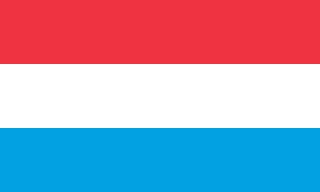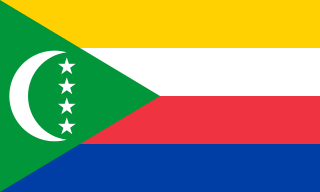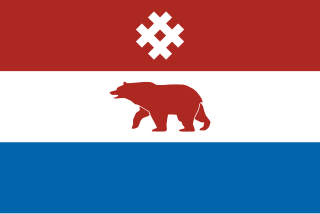
The national flag of France is a tricolour featuring three vertical bands coloured blue, white, and red. It is known to English speakers as the Tricolour, although the flag of Ireland and others are also so known. The design was adopted after the French Revolution, where the revolutionaries were influenced by the horizontally striped red-white-blue flag of the Netherlands. While not the first tricolour, it became one of the most influential flags in history. The tricolour scheme was later adopted by many other nations in Europe and elsewhere, and, according to the Encyclopædia Britannica has historically stood "in symbolic opposition to the autocratic and clericalist royal standards of the past".

The national flag of Luxembourg consists of three horizontal stripes, red, white and light blue, and can be in 1:2 or 3:5 ratio. It was first used between 1845 and 1848 and officially adopted in 1993. It is informally called in the country, «rout, wäiß, blo».

The national flag of Romania is a tricolour. The Constitution of Romania states that "The flag of Romania is tricolour; the colours are arranged vertically in the following order from the flagpole: blue, yellow, red". The flag has a width-length ratio of 2:3; the proportions, shades of colour as well as the flag protocol were established by law in 1994, and extended in 2001.

The national flag of Greece, popularly referred to as the "blue and white one" or the "azure and white", is officially recognised by Greece as one of its national symbols and has nine equal horizontal stripes of blue alternating with white. There is a blue canton in the upper hoist-side corner bearing a white cross; the cross symbolises Eastern Orthodox Christianity. The blazon of the flag is Azure, four bars Argent; on a canton of the field a Greek cross throughout of the second. The official flag ratio is 2:3. The shade of blue used in the flag has varied throughout its history, from light blue to dark blue, the latter being increasingly used since the late 1960s. It was officially adopted by the First National Assembly at Epidaurus on 13 January 1822. The nine stripes do not have any official meaning; the most popular theory says that they represent the syllables of the phrase Ελευθερία ή Θάνατος, the five blue stripes for the syllables Ελευθερία and the four white stripes ή Θάνατος. The nine stripes is also said to represent the letters of the word "freedom" . White and blue symbolise the colours of the Greek sky and sea.

The national flag of Switzerland displays a white cross in the centre of a square red field. The white cross is known as the Swiss cross or the federal cross. Its arms are equilateral, and their ratio of length to width is 7:6. The size of the cross in relation to the field was set in 2017 as 5:8. Alongside the flag of Vatican City, the Swiss flag is one of only two square national flags in the world.

The national flag of Turkey, officially the Turkish flag, is a red flag featuring a white star and crescent from its emblem. The flag is often called "the red flag", and is referred to as "the red banner" in the Turkish national anthem. The current Turkish flag is directly derived from the late Ottoman flag, which had been adopted in the late 18th century and acquired its final form in 1844. The measures, geometric proportions, and exact tone of red of the flag of Turkey were legally standardized with the Turkish Flag Law on 29 May 1936.

The national flag of the Union of the Comoros was designed in 2001 and officially adopted on 23 December of that year. It continues to display the crescent and four stars, which is a motif that has been in use in various forms since 1975 during the independence movement. In its constitution, the government of the Comoros refers to the insignia as l'emblème national, or the "national emblem", though it is understood to actually represent a flag.

The national flag of Tajikistan was adopted in November 1992, replacing the flag of the Tajik Soviet Socialist Republic of 1953. The flag is a horizontal tricolor of red, white and green, with a yellow crown surmounted by an arc of seven stars at the centre. It has a width ratio of 2:3:2. The tricolor preserves the choice of colors in the former Tajik Soviet flag, as well as the 1:2 proportions.

The flag of the United Nations is a sky blue banner containing the United Nations' emblem in the centre. The emblem on the flag is coloured white; it is a depiction of the world map in the azimuthal equidistant projection, which is surrounded by a pair of olive branches. The emblem was officially adopted on 7 December 1946, and the flag containing the emblem was officially adopted on 20 October 1947.

The coat of arms of the Swiss Confederation shows the same white-on-red cross as the flag of Switzerland, but on a heraldic shield instead of the square field.

First displayed in May 1935, Montreal based its flag on the city's coat of arms. It was revised in May 1939 and again in September 2017. The flag's proportions are 1:2 in a symmetric cross.
A civil ensign is an ensign used by civilian vessels to denote their nationality. It can be the same or different from the state ensign and the naval ensign. It is also known as the merchant ensign or merchant flag. Some countries have special civil ensigns for yachts, and even for specific yacht clubs, known as yacht ensigns.
The island nation of Malta has a variety of national flags and symbols, some current and some no longer in use.

The flag of Komi-Permyak Okrug, a federal subject of the Russian Federation, is a horizontal tricolor of red, white, and blue. In the center of the white stripe there is a red bear, and in the center of the red stripe a perna emblem in white. The perna is the cultural symbol of the Komi-Permyak people.

The flag of Ust-Orda Buryat Okrug, in the Russian Federation, is a blue field charged with a white argabar sun emblem within a golden disc. The disc is surrounded with four golden bezants at the cardinal positions. At the bottom of the flag is a white band charged with a red meander ornament, which symbolizes the lifestyle in the past and a prosperous future for the Buryat tribes.
The flag and emblem of Selangor are state symbols of Selangor, Malaysia. These two symbols are distinct from each other in style. Similar to other states of Malaysia with Malay royalties, both the flag and arms of Selangor are influenced by royalties, Islam, and political symbols of the state.

The Flag of the Austral Islands is the flag representing the Austral Islands, a constituent of French Polynesia in the Pacific Ocean administered by France.

The flag of Castilla–La Mancha is one of the representative symbols of the Autonomous Community of Castilla–La Mancha, in Spain, defined by its Statute of Autonomy.

The flag of Columbus is the official municipal flag of Columbus, Ohio. Its current design is a yellow, white, red vertical triband with the city seal on a blue field. Officially, the flag was adopted in 1929, although it is unknown if the flag was ever flown when it was first adopted.
The flag of Earth is a concept of a possible flag design meant to symbolize the planet Earth, humankind, or a possible world government.

























